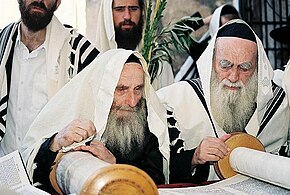
| Part of a series on |
| Judaism |
|---|
   |
Haredi Judaism (Hebrew: יהדות חֲרֵדִית, romanized: Yahadut Ḥaredit, IPA: [ħaʁeˈdi]) is a branch of Orthodox Judaism that is characterized by its strict interpretation of religious sources and its accepted halakha (Jewish law) and traditions, in opposition to more accommodating values and practices. Its members are usually referred to as ultra-Orthodox in English; a term considered pejorative by many of its adherents, who prefer the terms strictly Orthodox or Haredi (plural Haredim). Haredim regard themselves as the most authentic custodians of Jewish religious law and tradition which, in their opinion, is binding and unchangeable. They consider all other expressions of Judaism, including Modern Orthodoxy, as deviations from God's laws, although other movements of Judaism would disagree.[1]
Some scholars have suggested that Haredi Judaism is a reaction to societal changes, including political emancipation, the Haskalah movement derived from the Enlightenment, acculturation, secularization, religious reform in all its forms from mild to extreme, and the rise of the Jewish national movement. In contrast to Modern Orthodox Jews, Haredim segregate themselves from other parts of society, although some Haredi communities encourage young people to get a professional degree or establish a business. Furthermore, some Haredi groups, like Chabad-Lubavitch, encourage outreach to less observant and unaffiliated Jews.
As of 2020, there were about 2.1 million Haredim globally, representing 14% of the world's Jewish population.[2] Haredim primarily live in Israel (17% of Israeli Jews and 14% of the total population), North America (12% of American Jews), and Western Europe (most notably Antwerp and Stamford Hill in London). Absence of intermarriage coupled with both a high birth and retention rate spur rapid growth of the Haredi population which is on pace to more than double every 20 years. Their numbers have been further boosted since the 1970s by secular Jews adopting a Haredi lifestyle as part of the baal teshuva movement; however, this has been somewhat offset by those leaving.
- ^ Rubel, Nora L. (2010). Doubting the Devout: The Ultra-Orthodox in the Jewish American Imagination. Columbia University Press. p. 148. doi:10.7312/rube14186. ISBN 978-0-231-14187-1. JSTOR 10.7312/rube14186. Retrieved July 24, 2013.
Mainstream Jews have—until recently—maintained the impression that the ultraorthodox are the "real" Jews.
- ^ Staetsky, L. Daniel (May 2022). "Haredi Jews around the world: Population trends and estimates" (PDF). Institute for Jewish Policy Research.